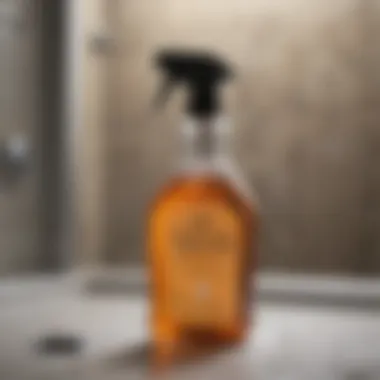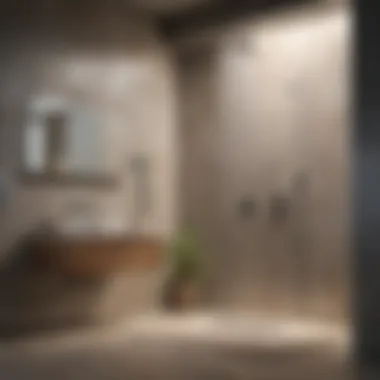Expert Insights on Effective Shower Water Stain Removers


Intro
Shower water stains can be both a nuisance and an eyesore. They often result from a combination of hard water minerals, soap scum, and environmental factors. These stains not only diminish the aesthetic appeal of bathrooms but can also contribute to hygiene issues if left untreated. Understanding the causes and effective solutions for these stains is crucial for maintaining a clean and inviting home. This article offers valuable insights into various methods of cleaning and preventing these marks, catering to homeowners, interior design enthusiasts, and gardening aficionados interested in a pristine living space.
In this guide, we will explore both commercial products and homemade remedies for removing water stains from showers. We will also discuss preventive measures to help avoid the buildup of stains in the first place. Each method will be analyzed for its effectiveness, safety considerations, and ease of use. The aim is to equip readers with the knowledge needed for a cleaner bathroom that enhances overall home aesthetics.
Understanding Shower Water Stains
Shower water stains represent both a practical and aesthetic concern for homeowners and design enthusiasts alike. Understanding the nature, common causes, and their impact on bathroom appearance is crucial for effectively addressing this issue. Water stains not only detract from the bathroom's visual appeal, but they may also indicate underlying problems such as excessive mineral deposits or poor ventilation. By gaining insight into these aspects, individuals can choose appropriate cleaning solutions, adopt preventative measures, and maintain a pristine and inviting atmosphere in their bathrooms.
Nature of Water Stains
Water stains are typically caused by minerals and soaps that accumulate on surfaces, particularly tile, glass, and fixtures. These stains can manifest in various forms, from light discolouration to more pronounced spotting, and can affect different materials in the bathroom. For example, hard water containing high levels of calcium and magnesium can leave behind a cloudy residue both on glass shower doors and ceramic tiles. The visible presence of these stains often serves as an indicator that regular maintenance is required, as they can worsen over time if left unaddressed. Medium to large-sized families or areas with hard water experience a higher frequency of staining, making understanding the nature of these stains essential for effective cleaning and maintenance.
Common Causes
Several factors contribute to the formation of shower water stains:
- Hard Water: Hard water is rich in minerals that leave deposits behind when water evaporates. This is the leading cause of stubborn stains.
- Soap Scum: The interaction between soap and minerals can create soap scum, which not only forms stains but can also hinder the efficiency of cleaners.
- Neglect of Routine Cleaning: Infrequent cleaning allows stains to accumulate, making them more challenging to remove. A proactive cleaning routine can mitigate such issues.
- Poor Ventilation: Inadequate airflow can promote humidity, leading to mould and mildew, which adds to unsightly stains over time.
Understanding these causes allows homeowners to recognize potential solutions and adjust their cleaning habits accordingly.
Impact on Bathroom Aesthetics
Water stains in the bathroom can significantly undermine its aesthetic value. Appearance is a critical aspect of any interior space. When visitors see stained surfaces, it creates an impression of negligence, even if the rest of the room is impeccably clean. Beyond the visual discomfort, stains can also contribute to a perception of uncleanliness, affecting the overall atmosphere one wishes to create in the space. Factors influencing the impact of water stains include:
- Location: Stains at eye level or on visibly prominent surfaces cause more distress than those hidden out of sight.
- Material Type: Glossy surfaces often highlight stains more than matte finishes. For instance, glass shower doors depict water stains more clearly than textured tiles.
- Color Contrast: Light-colored surfaces may show stains more readily than darker colors, leading to a more significant visual impact.
Attention to these aesthetic details is both a matter of personal preference and consideration for any guests who might use the bathroom.
Health Implications of Water Stains
Understanding the health implications of water stains in bathrooms is essential. Water stains can lead to the growth of mold and mildew, which are not only unpleasant to see but can also pose serious health risks. Recognizing these risks is crucial for maintaining a safe living environment. This section elaborates on two major health concerns caused by water stains: mold and mildew growth and respiratory concerns.
Mold and Mildew Growth
Mold and mildew thrive in damp areas, making bathrooms particularly prone to infestation. Water stains provide the perfect environment for these fungi to grow. When moisture accumulates, it creates a breeding ground that can spread quickly if not addressed.
Some types of mold release allergens and irritants. Exposure can lead to various health issues such as skin irritation, allergic reactions, and respiratory problems.
- Common types of mold linked to water stains:
- Aspergillus: Often found in bathrooms, it can trigger allergies and respiratory issues.
- Stachybotrys (black mold): Known for its health risks, it can cause more severe respiratory problems.
Addressing mold and mildew early is vital. Homeowners should regularly check for water stains and any signs of fungal growth. Proper cleaning and maintenance can reduce the risk of mold development, contributing to a healthier living space.
Respiratory Concerns
Water stains are often more than a cosmetic problem; they can lead to significant respiratory concerns. Mold spores, when inhaled, can result in respiratory irritation, especially for individuals with pre-existing conditions like asthma or allergies. In some cases, prolonged exposure can lead to chronic respiratory issues.
Researchers highlight the connection between indoor air quality and exposure to mold.
- Symptoms of mold-related respiratory issues include:
- Coughing
- Wheezing
- Shortness of breath
- Sinus congestion


Improving bathroom ventilation can be an effective way to minimize moisture accumulation, thus preventing water stains and subsequent mold growth. Homeowners are encouraged to use exhaust fans, open windows, or take other steps to ensure proper airflow in the bathroom.
"Proactive management of bathroom cleanliness and ventilation can greatly enhance indoor air quality and reduce health risks associated with mold exposure."
By understanding these health implications, homeowners can take necessary steps to maintain a cleaner, healthier bathroom environment.
Choosing the Right Stain Remover
Choosing the right stain remover is critical for effectively tackling shower water stains. This decision impacts not only the cleanliness of the bathroom but also the longevity of the surfaces involved. Different products have distinct ingredients that yield varying results. Homeowners and design enthusiasts must consider aspects such as effectiveness, safety, and environmental impact while selecting the appropriate solution.
When selecting among available options, users should contemplate the type of stains they deal with. Hard water stains, soap scum, and mildew all require different approaches for removal. Knowing the nature of the stain can guide the choice of product, ensuring a targeted solution that reduces time and effort.
Types of Commercial Products
There are several types of commercial products tailored for removing shower water stains. Understanding these will help consumers choose wisely based on their specific needs.
- Acidic Cleaners: Typically contain citric acid or phosphoric acid. These work well on hard water stains but can be harsh on certain surfaces, like natural stones.
- Alkaline Cleaners: Effective for soap scum removal, they often have surfactants that help lift the grime. However, they may not effectively tackle mineral deposits.
- Specialty Glass Cleaners: Designed specifically for glass surfaces, they can remove streaks and stains without damaging the fixture.
- All-Purpose Cleaners: Versatile and often containing a mix of surfactants and acids. These can be useful for regular maintenance but may not be potent enough for stubborn stains.
Considerations such as the surface material and potential health impacts should guide the selection. Always read labels carefully to ensure compatibility with your tiles and fixtures.
Homemade Solutions
Homemade solutions can offer effective alternatives to commercial products, often utilizing simple household ingredients. They tend to be more eco-friendly and can be tailored to specific types of stains.
- Vinegar and Baking Soda: A combination of these creates a fizzing reaction. This can help break down tough stains. Apply vinegar, let it sit, then sprinkle baking soda and scrub with a brush.
- Lemon Juice: Its natural acidity makes it a good option for hard water stains. Apply lemon juice directly, let it sit for a while, then rinse thoroughly.
- Borax: This common household mineral can be effective for scrubbing away soap scum and mineral buildup. Mix with water to create a paste for targeted cleaning.
While these methods are often effective, be aware that they can require more elbow grease compared to commercial solutions. Proper testing on a small area is advisable to avoid potential damage to your surfaces.
"Selecting the right stain remover is not merely about cleaning. It is about maintaining the integrity of your bathroom surfaces while ensuring a hygienic environment."
In summary, when choosing stain removers, weigh your options carefully. Understanding both commercial and homemade cleaners can guide you in maintaining a clean and visually appealing bathroom.
Application Techniques
Proper application techniques are essential when dealing with shower water stains. They can determine the effectiveness of the stain removal process. This section outlines crucial elements to consider and offers a structured approach to enhance the results of cleaning efforts. Correct application not only ensures better stain removal but also prolongs the life of both the cleaning products and the surfaces being treated.
Preparation of the Area
Before applying any cleaning solution, one must prepare the area effectively. Begin by removing any loose items from the shower space. This includes toiletries, towels, and bath mats. Such preparation allows for unobstructed access to surfaces, ensuring that you can focus on treating the stains directly.
In addition, it’s important to clear surfaces of any dirt or debris. Wipe the area down with a damp cloth to remove initial layers of grime. This small step can significantly improve the stain removal process, as products can better adhere to the stains without interference.
Finally, consider testing the cleaning product on a small, inconspicuous area first. This is essential to check for any adverse reactions with the surface materials.
Proper Usage of Products
Utilizing the right products correctly can maximize their effectiveness. Follow the instructions on the product label closely. Many stain removers require a specific method of application, like spraying from a certain distance or letting the solution sit for a while before rinsing. Ignoring these instructions can lead to subpar results.
Apply the product evenly over the stained surfaces. A sponge or cloth can help spread the solution uniformly without missing areas. For tough stains, it may be beneficial to scrub gently with a non-abrasive brush.
Also, avoid mixing different types of cleaning products together. Doing so can lead to hazardous reactions and diminish the product efficacy. Using one type at a time allows for better control over the process and enhances safety.
Rinsing and Drying Techniques
Rinsing effectively is as important as applying the product correctly. After allowing the stain remover to set as indicated, thoroughly rinse the area with plenty of clean water. Residual cleaning chemicals can leave new stains or damage surfaces over time.
When rinsing, it’s beneficial to use a detachable shower head or a bucket, ensuring you wash all corners and crevices. After rinsing, drying the surface properly can prevent the immediate formation of new stains. Use a squeegee or a microfiber cloth to remove excess water.


If concerned about water spots forming again, consider drying the shower after each use. This quick maintenance routine can make a significant difference in the overall cleanliness of the space.
Quick Tip: After using any stain remover, a quick wipe down with a dry cloth can enhance the shine and prevent water spots from returning.
Safety Considerations
Safety is a critical aspect when using any cleaning products, especially those aimed at removing stubborn water stains from showers. Knowledge of personal protective equipment and ventilation requirements can significantly enhance safety during the cleaning process, protecting both the individual and the surrounding environment.
Personal Protective Equipment
When engaging in the task of cleaning shower water stains, wearing the appropriate personal protective equipment (PPE) is essential. This typically includes:
- Gloves: Rubber or nitrile gloves safeguard your hands from harsh chemicals in commercial stain removers. Extended exposure can lead to skin irritations or allergic reactions.
- Goggles: Protective eyewear helps prevent irritation caused by splashes or airborne particulates created while scrubbing surfaces.
- Masks: Using a mask can protect your respiratory system from harmful vapors that may emerge from certain products.
To ensure a safe cleaning experience, it is wise to read the labels on cleaning products carefully. Each product may have specific recommendations for PPE, underscoring the importance of following these guidelines.
Ventilation Requirements
Proper ventilation is paramount while using chemical cleaners. Chemicals can release fumes that may be harmful if inhaled. Following are some critical steps to ensure adequate ventilation:
- Open Windows: If the bathroom has windows, open them to let fresh air in. This can help dissipate any fumes quickly.
- Use Exhaust Fans: Turn on the bathroom exhaust fan before starting the cleaning process. This helps to reduce humidity and allows chemical vapors to exit the space efficiently.
- Create Cross-Ventilation: If possible, open doors to other rooms or hallways to create a breeze that facilitates air exchange.
Important: Insufficient ventilation can lead to dizziness, nausea, or respiratory issues. Always prioritize airflow when using potent cleaners.
By taking these safety considerations seriously, individuals can effectively manage potential hazards during the removal of shower water stains. This awareness not only protects the cleaner but also ensures the long-term health of those who use the bathroom afterward.
Maintenance and Prevention
Maintaining a clean and aesthetically pleasing bathroom is essential for both hygiene and overall enjoyment of your space. Water stain prevention plays a vital role in protecting the integrity of your fixtures and tiles. By implementing effective maintenance strategies, homeowners can prolong the life of their bathroom surfaces, reduce cleaning frequency, and ultimately save time and money.
Regular upkeep also contributes to a more inviting atmosphere. A clean bathroom not only enhances the visual appeal but also minimizes the risk of mold and mildew growth, which can have detrimental effects on health. This section discusses fundamental practices for routine cleaning and the importance of selecting water-saving fixtures.
Routine Cleaning Practices
Routine cleaning practices serve as the first line of defense against water stains. By establishing a consistent schedule for cleaning, you can limit filthy buildup and maintain the integrity of surfaces in the shower and surrounding areas. Here are some key practices homeowners should consider:
- Daily Wipe Downs: After each use, a quick wipe down of the shower walls and fixtures with a squeegee or microfiber cloth can significantly reduce water stains. This step removes excess moisture that contributes to mineral deposits.
- Weekly Cleaning: Choose a specific day each week to conduct a more thorough cleaning. Use a non-abrasive cleaner formulated for your specific surface type. Pay special attention to areas prone to water buildup, such as grout and caulk lines.
- Monthly Deep Cleaning: Once a month, set aside time for a deep clean. This should include scrubbing all surfaces, including tiles, fixtures, and glass doors, using appropriate cleaners to remove stubborn stains and mildew.
"Consistent cleaning habits not only keep water stains at bay but also enhance the lifespan of your bathroom surfaces."
Adhering to these practices can make a noticeable difference in both the appearance and hygiene of your bathroom. Investment in time for routine maintenance pays off.
Choosing Water-Saving Fixtures
The choice of fixtures plays a crucial role in preventing water stains in the shower. Water-saving fixtures not only reduce the number of minerals deposited on surfaces but also contribute positively to environmental conservation efforts. Here’s why these fixtures are beneficial:
- Reduced Water Usage: Low-flow showerheads and faucets use less water without compromising performance. The result is less water that can evaporate and leave behind mineral deposits.
- Enhanced Efficiency: By choosing water-saving fixtures, you contribute to long-term savings on water bills. These savings are an essential consideration, particularly in regions with rising utility costs.
- Improved Overall Bathroom Experience: Many modern water-saving fixtures come with advanced technologies, providing a more enjoyable shower experience with efficient water flow.
Evaluating Product Efficacy
Evaluating the efficacy of shower water stain removers is critical for anyone seeking to maintain a clean and appealing bathroom. With numerous products available, it is essential to differentiate between ones that truly deliver results and those that merely promise to do so. Consideration of specific elements such as active ingredients, consumer satisfaction, and demonstrable results plays a crucial role in making a well-informed decision. The ultimate goal is to select a product that not only clears existing stains but also prevents future buildup, enhancing the overall hygiene and aesthetic appeal of the space.
Consumer Reviews and Ratings
Consumer reviews serve as a valuable resource when determining the effectiveness of a product. These firsthand accounts provide insight into real-world experiences, highlighting both successes and failures associated with various stain removers. It is advisable to seek products with high ratings and positive feedback across multiple platforms.


Factors to analyze in reviews include:
- Ease of Use: Is the product user-friendly? Detailed reviews often address the clarity of instructions and the comfort level during application.
- Effectiveness: Many reviews will fall back on how well the product works in removing water stains. Specific details about the severity of stains and how quickly the product performed can be very telling.
- Safety and Ingredients: Reviews will often mention any adverse reactions or concerns about chemical ingredients, offering a sense of security for sensitive users.
- Value for Money: Do users feel they received enough efficacy for the price paid? This also factors into the overall rating of a product.
Shopping from credible platforms like amazon or home depot allows for a more transparent view of ratings through verified purchases.
Case Studies on Product Performance
Case studies can provide a more structured and analytical view of how specific products perform in various conditions. These studies often involve controlled environments, measuring the effectiveness of different stain removers over time.
When engaging with case studies, consider:
- Conditions of Testing: Were the products tested in real bathroom scenarios or artificial settings? Real-world testing tends to yield results more relevant for home use.
- Metrics: What specific metrics were used to gauge performance? Common measures include the time taken to remove stains, the number of applications required, and any leftover residue post-application.
- Comparative Analysis: Some studies compare several popular products side-by-side. This can reveal which products outshine their competitors and under what circumstances they do so.
Delving into these case studies and their results offers a clearer picture for consumers. It also aids in identifying any long-term impacts of products on surfaces, which is critical for homeowners to consider.
"Understanding product efficacy not only saves time and money but also ensures a healthier living environment."
By evaluating both consumer reviews and in-depth case studies, homeowners can make better-informed decisions about shower water stain removers. This methodical analysis connects directly to the maintenance of an aesthetically pleasing and hygienic bathroom.
Environmental Considerations
Environmental considerations play a crucial role in the discourse surrounding shower water stain removers. As society becomes more aware of ecological issues, the demand for cleaning products that are safe for both users and the environment grows. This section will discuss two main aspects: the biodegradability of products and their impact on plumbing systems.
Biodegradability of Products
When purchasing a stain remover, it is essential to evaluate its biodegradability. This term refers to the ability of substances to be broken down naturally by microorganisms. Non-biodegradable products can accumulate in landfills and waterways, posing risks to wildlife and ecosystems. Biodegradable products, on the other hand, decompose into harmless substances, reducing their environmental footprint.
Benefits of biodegradable products include:
- Reduced pollution: They contribute less to water and soil contamination.
- Safety for aquatic life: When washed away, they minimize harm to fish and other marine organisms.
- Less chemical exposure: With fewer toxic ingredients, they are typically safer for household members and pets.
Consumers should look for labels indicating biodegradability. Materials like citric acid and vinegar, often found in homemade solutions, are excellent choices. These alternatives not only clean effectively but also decompose quickly and safely.
Impact on Plumbing
The use of stain removers can also have significant implications for plumbing systems. Some commercial products contain harsh chemicals that may corrode pipes over time. Regular use of such substances can lead to blockages or deterioration of plumbing. Hence, understanding the impact on plumbing is vital for maintaining both functionality and safety.
Additionally, safer products can also enhance the longevity of plumbing systems. Here are some considerations:
- Chemical Composition: Opt for products that are free of phosphates and strong acids. They are less likely to cause damage.
- Frequency of Use: Using aggressive products frequently increases the chance of plumbing issues. Balancing product use with routine maintenance can effectively alleviate the risk.
- Professional Advice: Consulting with plumbing experts can provide tailored recommendations and enhance awareness about long-term product consequences.
"Choosing the right cleaning product not only benefits your home but also safeguards our planet."
Awareness regarding these environmental factors can guide consumers toward more sustainable choices. Choosing biodegradable stain removers and considering plumbing impacts ultimately fosters a healthier home and environment.
End
In the context of removing shower water stains, summarizing the key points presents significant value to both homeowners and interior design professionals. These insights emphasize practical methods for maintaining a clean and appealing bathroom. Effective stain removal contributes not only to aesthetics but also to surface longevity, which can prevent costly repairs or replacements.
Summary of Key Points
The discussion about shower water stain removers has several crucial takeaways:
- Understanding Water Stains: Recognizing the nature and causes of water stains gives clarity on the best approaches for cleaning. This knowledge helps in identifying stains promptly to avoid escalation.
- Health Implications: Awareness of mold and mildew risks connected with water stains is vital for household health. Regular cleaning can mitigate potential respiratory issues.
- Choosing the Right Product: Knowing the difference between commercial products like CLR and homemade solutions, such as vinegar-baking soda mixtures, can guide effective stain treatment.
- Application Techniques: Proper preparation and usage techniques are essential for optimum results. Following correct rinsing and drying procedures enhances the efficacy of stain removers.
- Safety Precautions: Emphasis on personal protective equipment and proper ventilation outlines the importance of safety during cleaning.
- Maintenance: Adopting routine cleaning practices and considering water-saving fixtures promotes long-term hygiene and aesthetic appeal.
Final Thoughts on Maintenance
Maintaining a stain-free shower is a continual effort that yields satisfying results. By frequently assessing areas prone to stains, a more proactive approach can be taken. The selection of appropriate cleaning products is essential, not only for efficacy but also for environmental consideration.
Regular maintenance practices like immediate cleaning after showering can significantly reduce stain formation. This small habit can have a big impact on the overall cleanliness of the bathroom, extending the lifespan of surfaces and keeping the ambiance inviting.
To sum up, understanding the mechanics behind water stains, employing suitable removal techniques, and fostering consistent maintenance will ensure a healthier, visually appealing shower environment. Ultimately, a well-maintained bathroom reflects thoughtful design and care, resonating with both practicality and aesthetic values.



